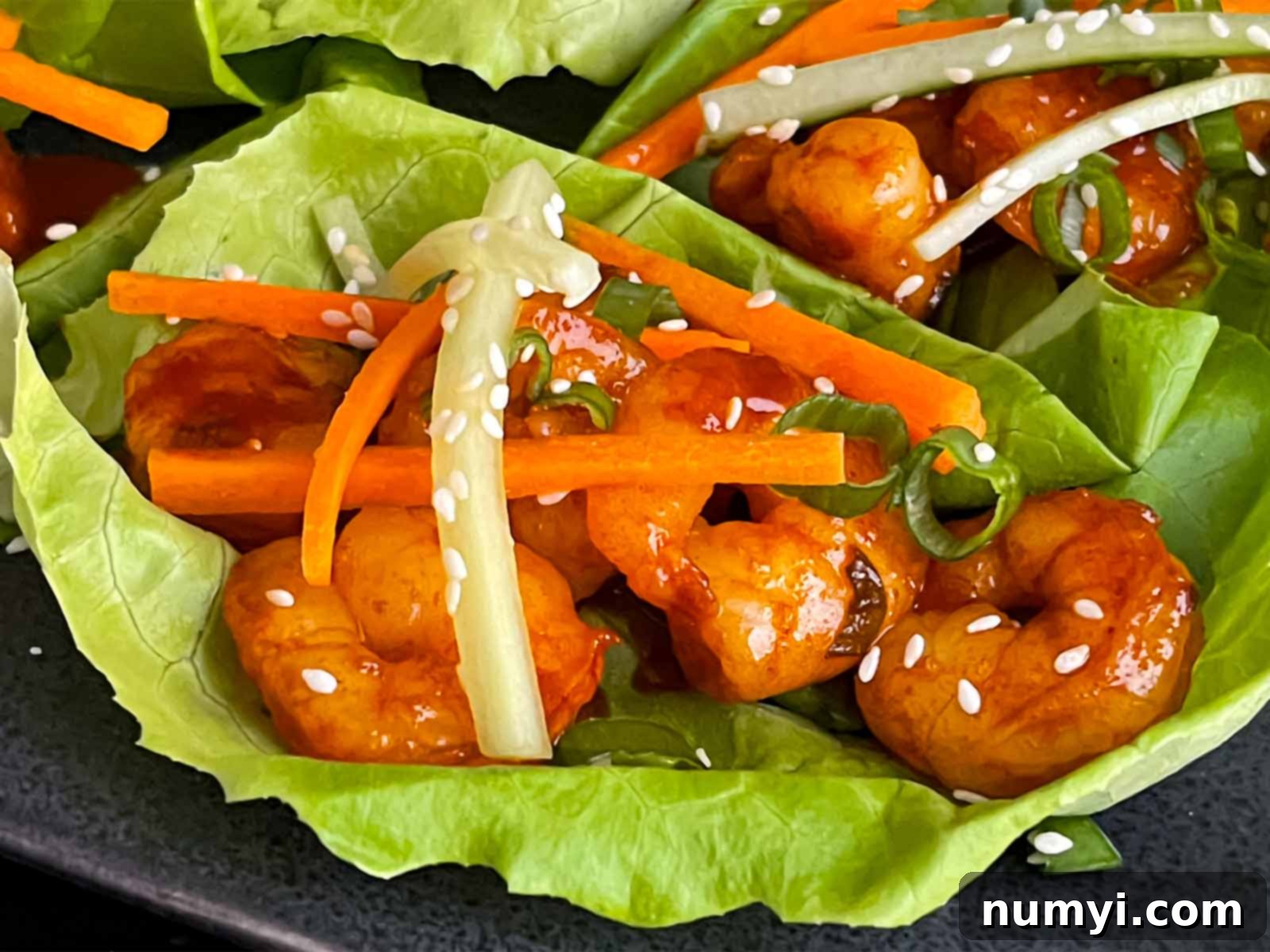Spicy Gochujang Shrimp Lettuce Wraps: A Quick & Healthy Korean-Inspired Meal
Dive into a world of vibrant flavors and satisfying textures with these Gochujang Shrimp Lettuce Wraps! Forget the usual chicken lettuce wraps; this recipe offers an exciting, spicy, and refreshingly crisp alternative that’s perfect for any occasion. Each bite delivers a delightful contrast between the fiery Gochujang-infused shrimp and the cool, crunchy vegetables, all nestled in a fresh lettuce cup. It’s a dish that tantalizes your taste buds while keeping things light, healthy, and incredibly easy to prepare.
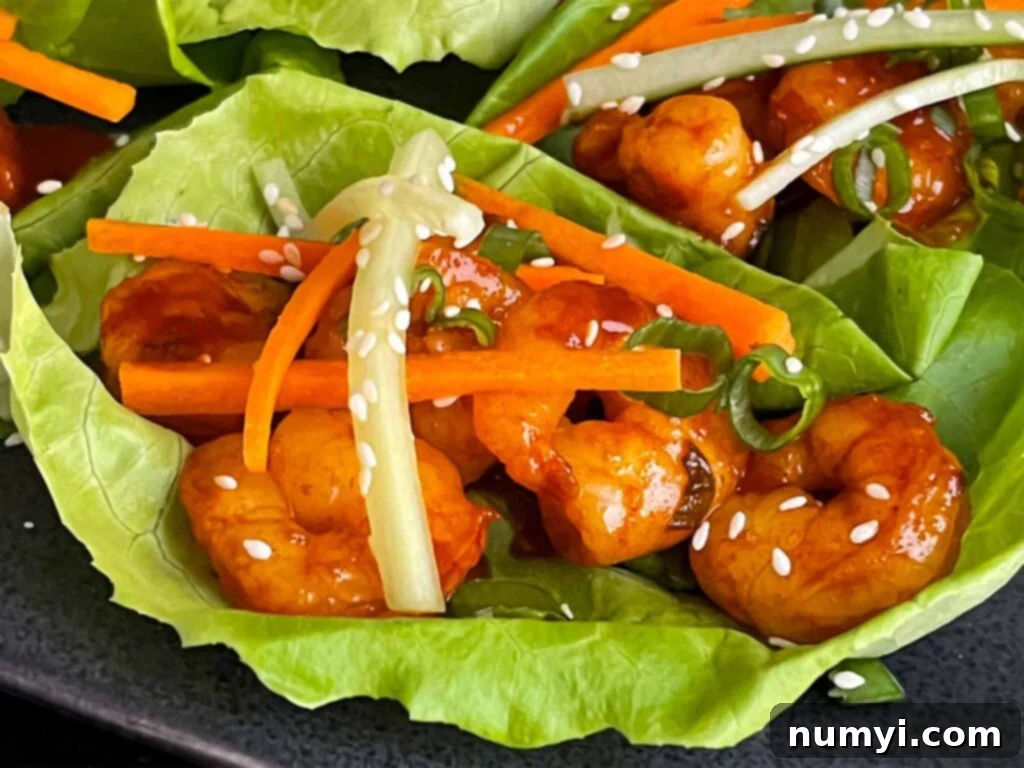
Why You Will Absolutely Love This Gochujang Shrimp Recipe
These Gochujang shrimp lettuce wraps are more than just a meal; they’re an experience. They stand out as a fantastic culinary choice for several compelling reasons, making them a staple in many kitchens, especially when you crave something both flavorful and health-conscious.
A Symphony of Flavors and Textures
What truly sets this dish apart is the incredible interplay of flavors and textures. The succulent shrimp, cooked to perfection and coated in a bold Gochujang sauce, brings a wonderful spicy kick and a deep umami savoriness. This heat is beautifully balanced by the coolness and crispness of fresh vegetables like matchstick-cut cucumber, shredded carrot, and aromatic green onion, creating a harmonious contrast in every mouthful. The tender shrimp, combined with the satisfying crunch of the lettuce and julienned veggies, offers an exciting sensory experience that keeps you coming back for more. It’s a perfect blend of sweet, spicy, and savory that invigorates the palate.
Light, Healthy, and Guilt-Free Dining
If you’re looking for a meal that doesn’t sacrifice flavor for health, you’ve found it. These Gochujang shrimp lettuce wraps are remarkably low in calories, making them an excellent option for those mindful of their dietary intake or looking for lighter alternatives. By utilizing crisp lettuce leaves instead of traditional wraps or bread, you significantly reduce carbohydrate content, allowing the natural goodness of the lean shrimp and fresh vegetables to shine. Packed with protein and fiber, it’s a meal that leaves you feeling satisfied, nourished, and energized, not heavy or sluggish, perfect for a balanced lifestyle.
Effortless Preparation for Busy Lives
In today’s fast-paced world, quick and easy recipes are invaluable. This Gochujang shrimp recipe comes together in less than 30 minutes from start to finish. This makes it an ideal choice for a bustling weeknight dinner, a last-minute appetizer for unexpected guests, or a refreshing, delicious lunch that doesn’t demand extensive time in the kitchen. The minimal cooking time also means less time spent heating up your kitchen, which is a welcome bonus, especially during warmer months when you’re seeking light and refreshing meals that keep your home cool and comfortable.

Exploring the Magic of Gochujang: A Korean Flavor Sensation
For those unfamiliar, Gochujang is a cornerstone of Korean cuisine, a deeply flavorful fermented chili paste that offers a unique combination of sweet, savory, and spicy notes, along with a distinct umami depth. Its fermentation process contributes to a complex flavor profile that elevates any dish it touches beyond mere heat. We’ve become huge fans of this versatile ingredient, incorporating it into a variety of our recipes due to its ability to add incredible depth and character. If you’re new to Gochujang, prepare to be amazed by its ability to transform simple ingredients into something extraordinary. This recipe is a fantastic introduction to its incredible potential and addictive taste.
If you’re already a fan of bold, spicy flavors and want to explore more dishes featuring this incredible Korean condiment, be sure to check out our other delicious recipes. You’ll love our Smoked Spicy Korean Gochujang Chicken Legs for a smoky, fiery kick, Kimchi Fried Rice for another comforting and flavorful Korean classic, Bang Bang Chicken for a creamy, spicy treat, and our Crispy Baked Asian Chicken Wings for a perfect game-day snack. For a milder lettuce wrap experience, our very tasty Chicken Lettuce Wraps recipe is also a must-try!
Essential Ingredients for Your Gochujang Shrimp Lettuce Wraps
One of the beauties of this recipe is its reliance on readily available ingredients. You won’t need to hunt for exotic items; everything can be found at your local grocery store. The key is to select fresh, high-quality produce and shrimp to ensure the best possible flavor and texture for your wraps. The balance of fresh ingredients with the punchy Gochujang is what makes this dish truly special.
The core components of this dish include succulent shrimp, which serves as the star protein, along with a vibrant medley of crisp carrots, refreshing cucumbers, and aromatic green onions that provide vital crunch and coolness. Of course, the distinctive spicy-sweet-umami flavor comes from the Gochujang itself, complemented by a touch of dark soy sauce to create that irresistible spicy and savory glaze. A little butter and sesame oil initiate the cooking process, infusing the shrimp with rich, nutty undertones. For a full list of ingredients and precise measurements, please refer to the comprehensive recipe card below, where you’ll find everything you need to recreate this masterpiece.
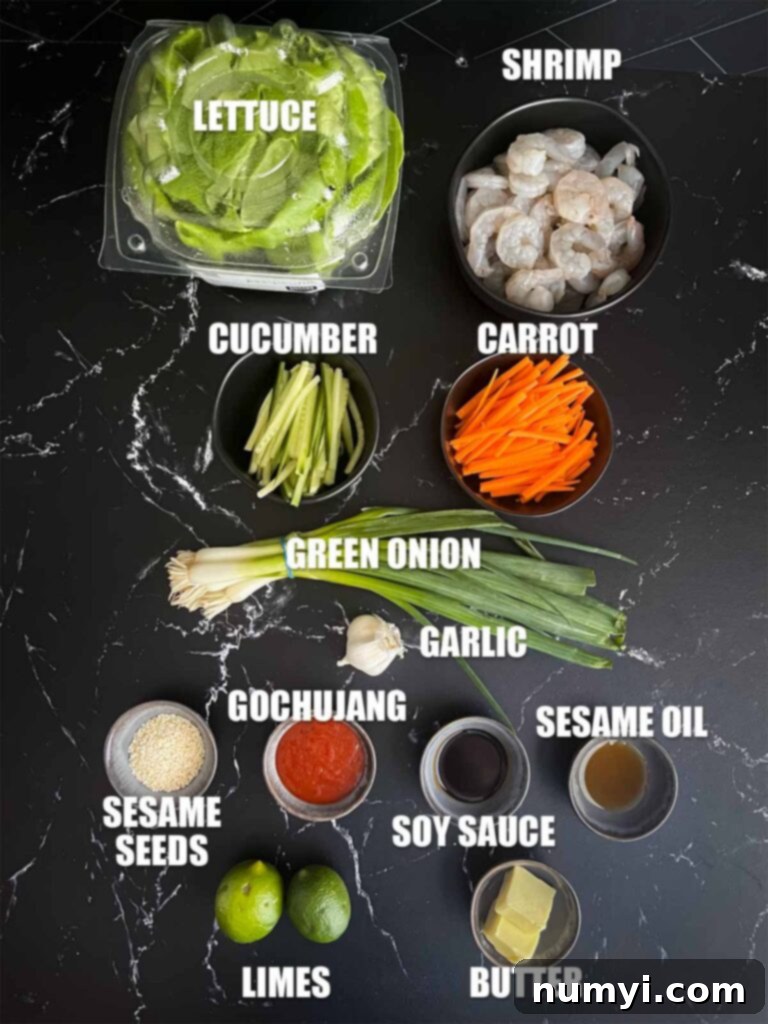
Step-by-Step Guide: How to Craft Gochujang Shrimp Lettuce Wraps
Creating these delightful Gochujang shrimp lettuce wraps is a straightforward process, designed for efficiency without compromising on flavor. Follow these simple steps to bring this spicy, refreshing dish to life in your kitchen in under 30 minutes, ensuring a delicious and satisfying meal every time.
1. Prepare Your Vegetables and Garnishes
Begin by meticulously preparing your green onions. First, separate the vibrant green portions from the white bases. The green parts will be sliced on a bias into appealing 1-inch pieces, destined for the fresh topping mixture that provides a crucial cool contrast. The white portion should be thinly sliced into small rounds, as it will be sautéed to build a fragrant and savory base for the shrimp.
Next, prepare your carrot and cucumber. For the best texture and visual appeal, cut them into thin matchstick pieces, also known as julienning. This ensures they integrate well into the wraps, adding a pleasant and even crunch without being cumbersome. Combine these finely julienned carrots and cucumbers with the previously chopped green onion greens in a small bowl. Sprinkle in the sesame seeds, which add a subtle nutty flavor and visual interest to the fresh topping. Gently toss to combine, then set this colorful vegetable medley aside – it’s the perfect refreshing component to our spicy shrimp.
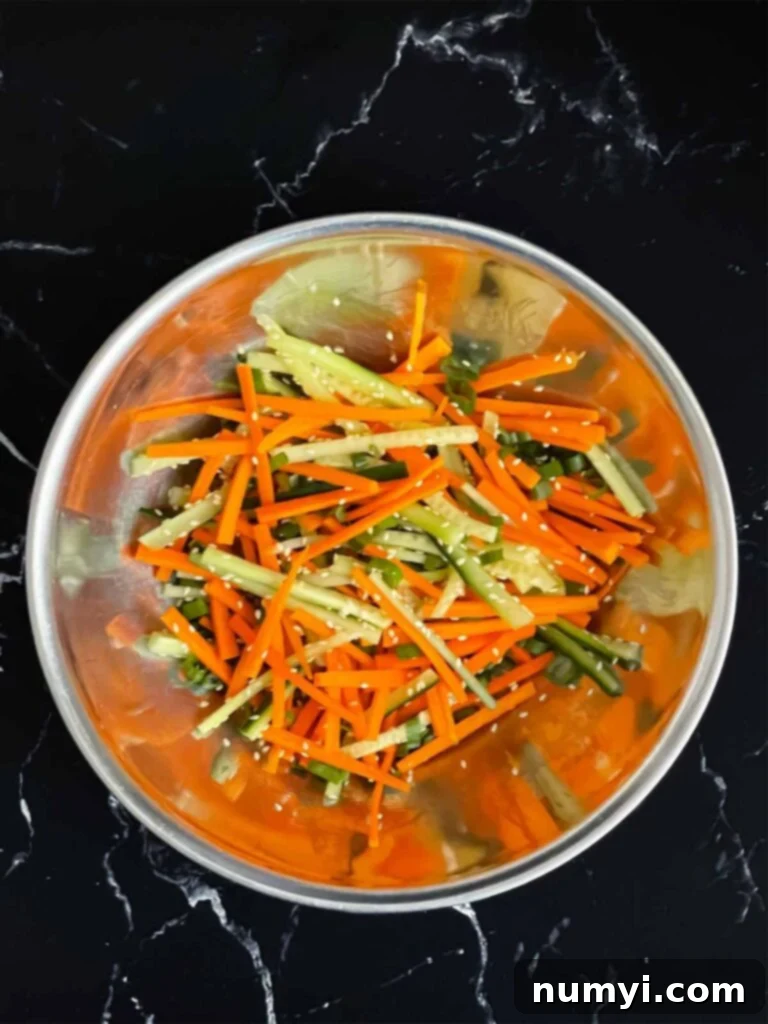
2. Build the Aromatic Base for the Shrimp
Heat a large skillet or wok over medium heat. Add the butter and sesame oil. The combination of these two fats provides a rich and complex foundation for our shrimp, with the sesame oil contributing a distinctive nutty, earthy, and aromatic note that is characteristic of Asian cuisine. Watch carefully for the butter to fully melt and the mixture to shimmer lightly, indicating it’s reached the ideal temperature for the next step.
Once the skillet is adequately heated and the fats are ready, add the thinly sliced white part of the green onion and the minced garlic. Sauté these aromatics gently, stirring continuously, until they become intensely fragrant and begin to soften, turning slightly translucent. This usually takes about 1 to 1.5 minutes. It’s crucial to avoid burning the garlic, as it can quickly turn bitter and overpower the dish. This step is fundamental for infusing the cooking oil with deep, savory, and pungent flavors that will enhance the shrimp.
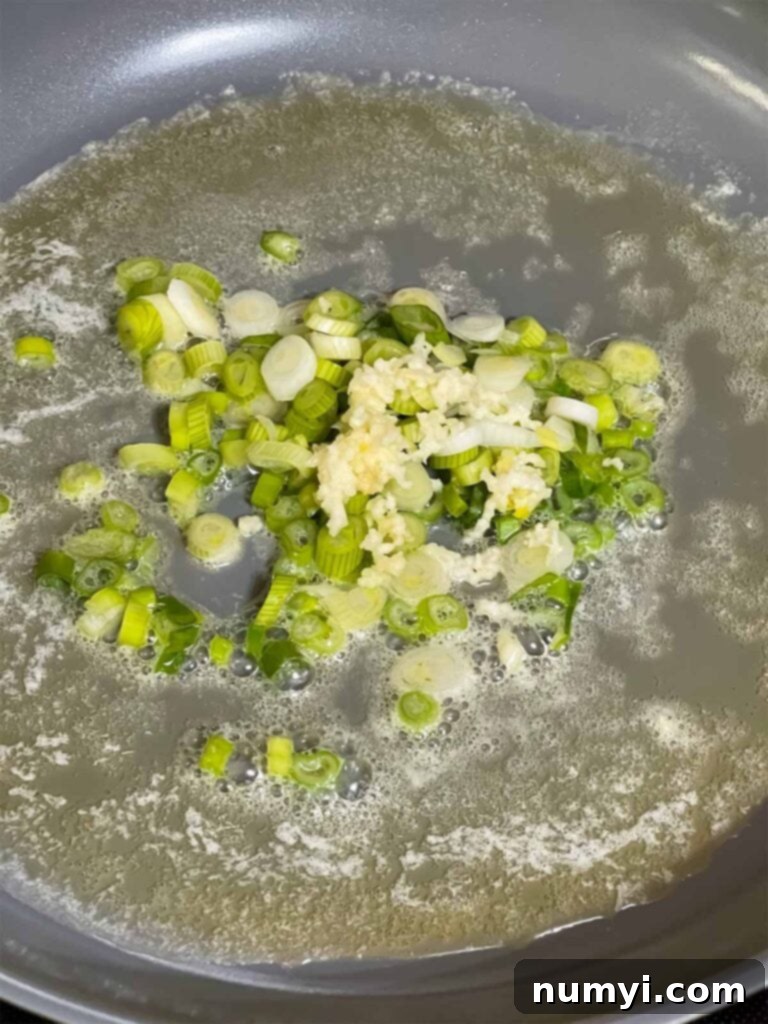
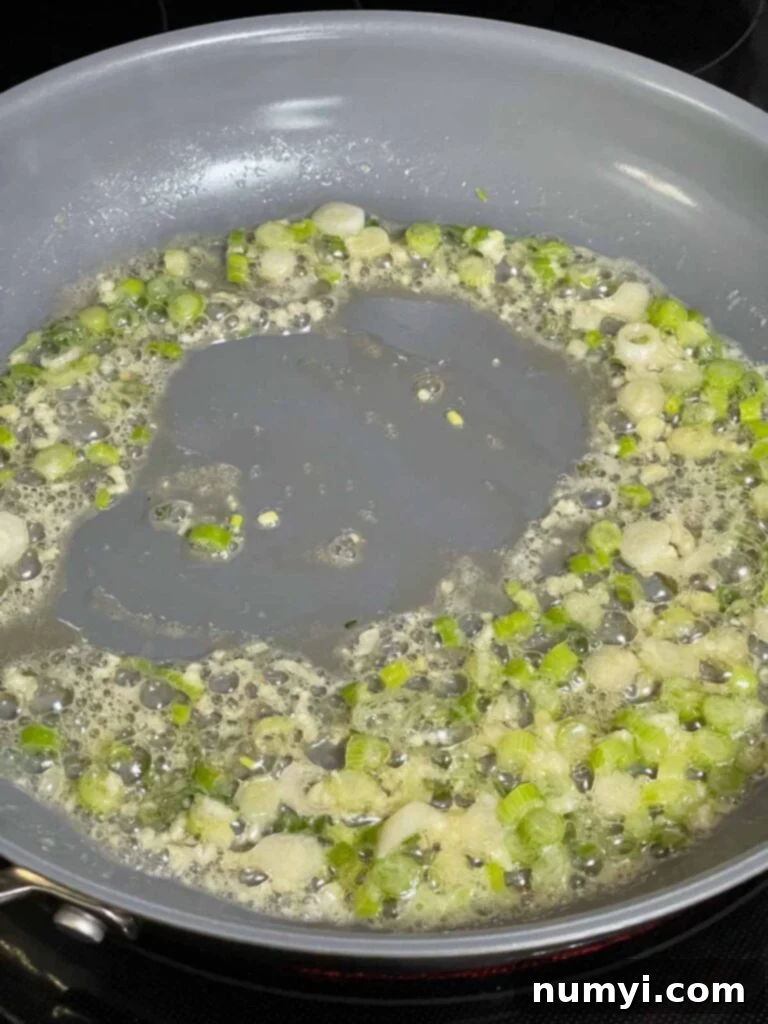
3. Cook the Shrimp to Perfection
Add the peeled and deveined shrimp to the skillet with the fragrant aromatics. Ensure the shrimp are in a single layer as much as possible to promote even cooking. Cook the shrimp, stirring occasionally to ensure all sides are exposed to the heat, for approximately three to four minutes. Shrimp cooks incredibly quickly, and the key to tender, juicy shrimp is to avoid overcooking, which can rapidly turn them rubbery and unappetizing. You’ll know they are perfectly cooked when they turn opaque and pink throughout, with a slight curl.
4. Infuse with Gochujang and Create the Glaze
Once the shrimp are perfectly cooked, it’s time to infuse them with their signature flavor. Add the Gochujang and dark soy sauce directly into the pan with the shrimp. Stir everything together thoroughly and gently, ensuring each individual shrimp is beautifully and evenly coated in the rich, spicy, and savory sauce. The residual heat from the pan will help the Gochujang release its full aroma and complex flavor, creating an irresistible, glossy glaze that clings to the shrimp. Immediately remove the skillet from the heat to prevent the shrimp from overcooking and to keep the sauce from reducing too much or burning.
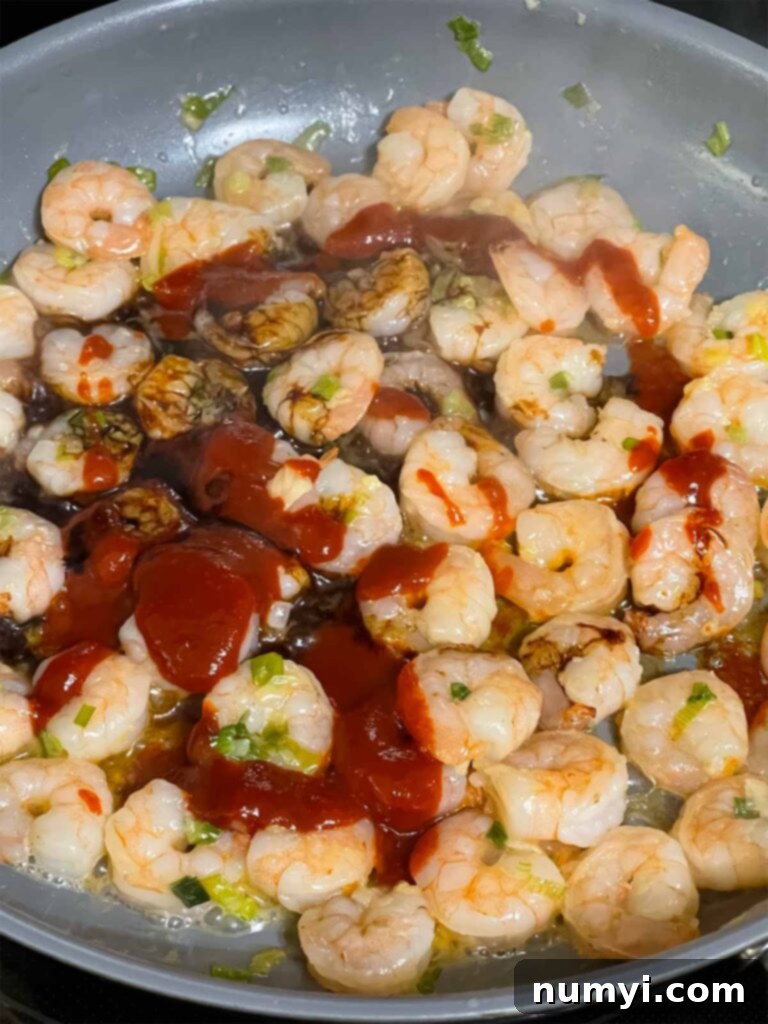

5. Assemble and Serve Your Flavorful Wraps
Now for the most satisfying part: assembly! Take your favorite prepared lettuce leaves (we’ll discuss ideal choices in the tips section below) and spoon a generous amount of the warm, spicy Gochujang shrimp into the center of each leaf. Then, artfully arrange a portion of your crisp green onion, cucumber, and carrot mixture on top of the shrimp. The contrast in color, temperature, and texture between the warm, spicy shrimp and the cool, crunchy vegetables is visually appealing and contributes significantly to the overall deliciousness and balance of the dish.
For an extra burst of freshness and a bright, zesty finish that truly elevates the flavors, squeeze a wedge of fresh lemon or lime over the assembled wraps just before serving. This optional but highly recommended step adds a wonderful citrusy note that cuts through the richness and spice, making each bite even more invigorating. Serve immediately and encourage guests to build their own for a fun, interactive dining experience!
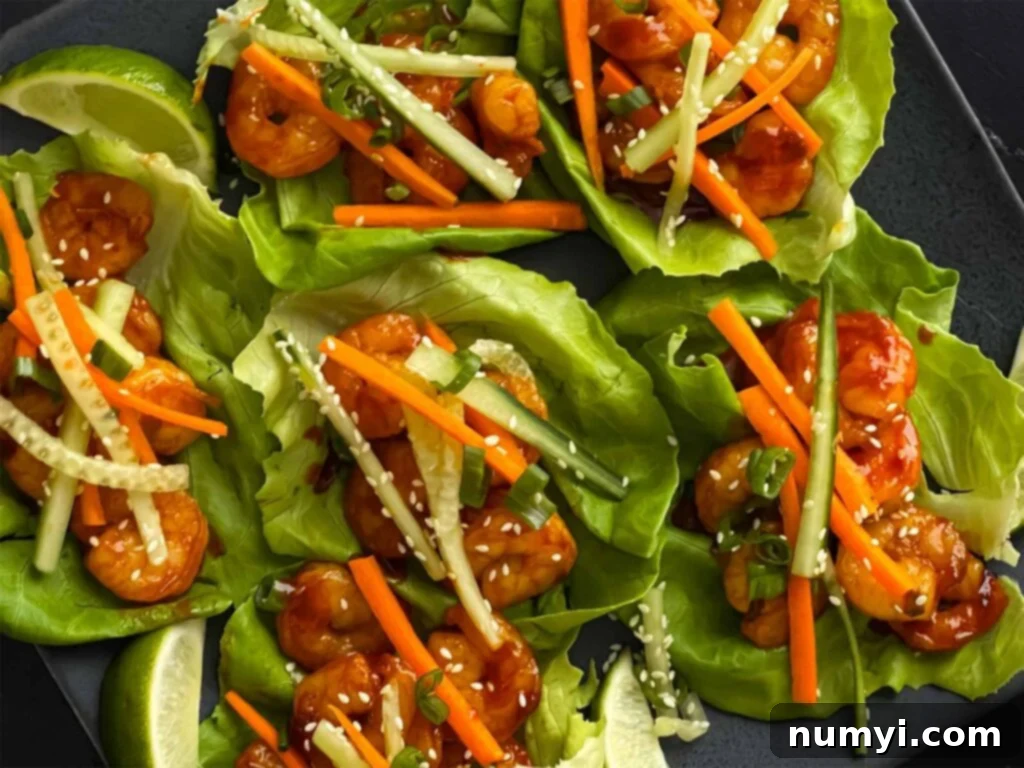
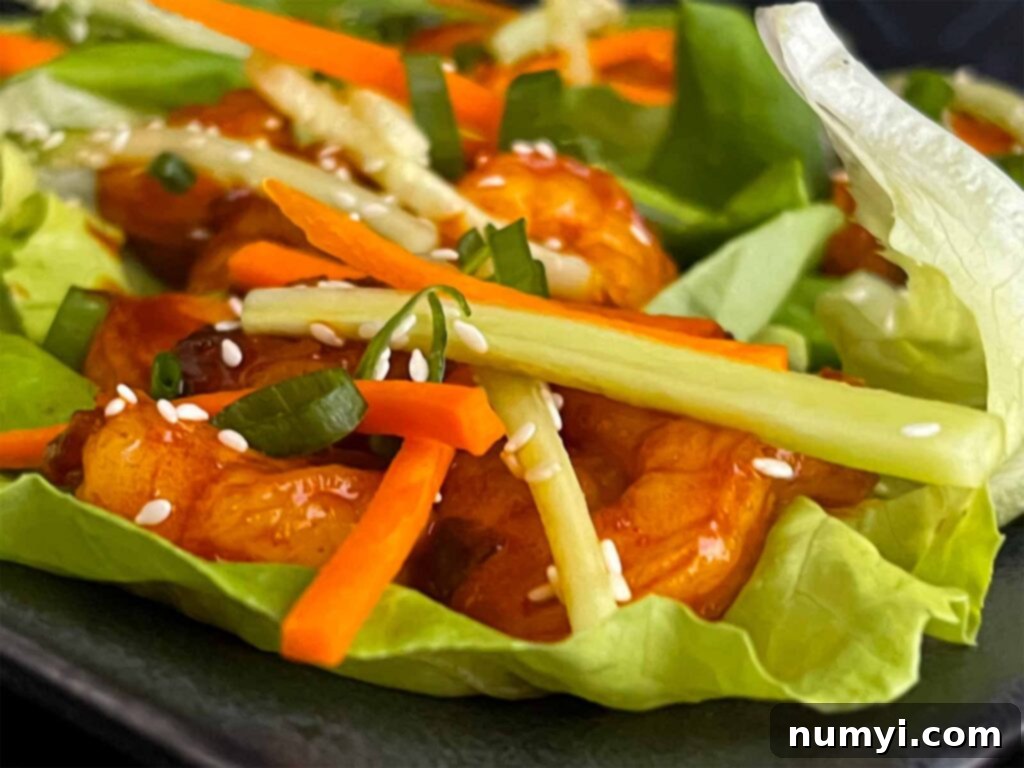
Expert Tips for Crafting the Best Gochujang Shrimp Lettuce Wraps
Achieving the perfect lettuce wrap involves a few key considerations that can elevate your dish from simply good to truly outstanding. Here are some expert tips to ensure your Gochujang Shrimp Lettuce Wraps are always a hit, delivering maximum flavor and an enjoyable eating experience:
Choosing the Right Lettuce Leaves
The foundation of any great lettuce wrap is, of course, the lettuce itself. The right type of lettuce provides both structural integrity for holding the filling and a complementary texture and flavor profile. A good lettuce leaf should be crisp, fresh, and robust enough to cradle the ingredients without tearing or becoming soggy too quickly:
- Butter Lettuce (Boston or Bibb): This is our top recommendation and what we used for our wraps. Butter lettuce leaves are wonderfully soft, pliable, and possess a natural cup-like shape, making them ideal for holding generous fillings without tearing. Their delicate, slightly sweet flavor also harmonizes beautifully with the spicy, savory shrimp, adding a subtle richness.
- Romaine Lettuce: A fantastic and widely available alternative, Romaine offers a satisfying crunch and a sturdy structure. Its elongated leaves can be cut in half or simply used as is, providing a robust container for your filling. The slightly bitter and peppery notes of Romaine can also provide an interesting contrast to the Gochujang’s inherent sweetness and spice, creating a more complex flavor profile.
- Iceberg Lettuce: If you’re after maximum crispness and a refreshing, almost watery bite, Iceberg lettuce is a classic option. However, be aware that its brittle nature makes it more prone to breaking when folded, and it generally has a milder flavor compared to butter or Romaine lettuce. You might need to use larger, outer leaves to ensure they hold up well, and it’s best enjoyed very fresh.
Regardless of your choice, ensure the lettuce is thoroughly washed and dried, ideally with a salad spinner or by patting it dry with paper towels. Excess moisture can make your wraps soggy and dilute the flavors.
Selecting Your Soy Sauce
Soy sauce is a critical component of the Gochujang glaze, adding depth, saltiness, and umami. You have options to tailor it to your preferences or dietary needs:
- Regular Soy Sauce: Provides a robust, classic flavor profile that is widely recognized.
- Light Soy Sauce: Often refers to the standard, all-purpose soy sauce, offering a balanced flavor without being overly heavy.
- Low Sodium Soy Sauce: A great choice for those monitoring their sodium intake, allowing you to control the saltiness of the dish more precisely without compromising on the soy flavor.
- Tamari: For a gluten-free option, Tamari is an excellent substitute, offering a similar rich flavor profile that is often slightly deeper and less salty than standard soy sauce.
Experiment with different types to find what you like best, but remember that a high-quality soy sauce will always enhance the overall taste and complexity of your Gochujang glaze.
Don’t Overstuff Your Wraps
While it’s tempting to load up each lettuce leaf with as much delicious filling as possible, resist the urge to overstuff. An overloaded wrap is difficult to handle, messy to eat, and prone to falling apart. Aim for a balanced portion of shrimp and vegetables that allows for easy folding or wrapping and a clean, enjoyable bite. It’s better to have more wraps than one giant, unmanageable one.
Serve Immediately for Best Texture
Lettuce wraps are a dish best enjoyed fresh. The exquisite contrast between the warm, perfectly cooked Gochujang shrimp and the crisp, cool vegetables and lettuce is at its peak immediately after assembly. While individual components can be prepared ahead of time (see FAQ section for meal prep tips), it is highly recommended to assemble the wraps just before serving to prevent the lettuce from wilting and the vegetables from losing their refreshing crunch.
Creative Variations & Customizations for Your Lettuce Wraps
One of the joys of cooking is the freedom to customize and experiment. These Gochujang Shrimp Lettuce Wraps are incredibly versatile, allowing you to adapt them to your taste, dietary preferences, or whatever ingredients you happen to have on hand. Don’t be afraid to get creative and make this recipe your own!
Protein Alternatives
While shrimp is undoubtedly delicious and a fantastic choice for this recipe, you can easily swap it out for other proteins to create a different flavor and texture experience. This makes the recipe highly adaptable for various preferences:
- Grilled or Ground Chicken: Marinate thinly sliced chicken strips or ground chicken in a mixture similar to the Gochujang sauce before cooking. For strips, grilling, pan-frying, or stir-frying works wonderfully. Ground chicken can be cooked directly in the skillet until browned and then mixed thoroughly with the Gochujang sauce for a hearty filling.
- Tofu or Tempeh: For a vegetarian or vegan option, firm or extra-firm tofu or tempeh can be pressed to remove excess water, then cubed or crumbled. Pan-fry or bake it until it achieves a crispy texture. Then, toss it with the Gochujang sauce for a flavorful and protein-rich plant-based alternative that mimics the texture of meat.
- Beef Strips: Thinly sliced beef (such as sirloin, flank steak, or even ground beef) can be quickly stir-fried with the Gochujang sauce for a richer, heartier wrap. Ensure you slice against the grain for maximum tenderness, and cook quickly over high heat to keep the beef juicy.
Adjusting the Spice Level
Gochujang offers a moderate to robust heat, but you can easily tailor the spiciness to perfectly match your preference, from mild to extra fiery:
- Increase the Heat: For a fierier kick, feel free to add a dash of red pepper flakes (gochugaru for an authentic touch), a bit more Gochujang, or a drizzle of sriracha or other chili oil to the shrimp mixture while it’s cooking. Freshly sliced chilies can also add a vibrant, immediate heat.
- Reduce the Heat: If you prefer a milder flavor profile, simply decrease the amount of Gochujang used in the recipe. You can also balance any residual heat by adding a tiny pinch of sugar, a teaspoon of honey, or a splash of mirin to the sauce, which will mellow the spice without sacrificing the complex flavor. A dollop of plain yogurt or sour cream on top of the finished wrap can also provide a cooling effect.
Enhanced Flavor Profiles and Additional Sauces
Introduce additional sauces or ingredients to explore new dimensions of flavor and complexity beyond the core Gochujang profile:
- Hoisin Sauce: Adding a tablespoon of hoisin sauce brings a distinct sweet, tangy, and savory depth, reminiscent of Chinese barbecue flavors. It complements the Gochujang beautifully, adding a lovely glaze and richness.
- Oyster Sauce: A spoon of oyster sauce can add a rich, umami, and slightly sweet seafood flavor, enhancing the overall savoriness of the dish and providing a thicker consistency to the glaze.
- Nutty Notes: For an extra layer of texture and flavor, a drizzle of creamy peanut sauce, tahini, or a generous sprinkle of crushed peanuts on top of the finished wraps can add a wonderful nutty element that pairs exceptionally well with Asian flavors.
- Ginger: Freshly grated ginger added with the garlic and green onions can boost the aromatic qualities and add a subtle zing.
Additions for Texture and Crunch
Beyond the core vegetables, consider these delicious additions to boost texture, visual appeal, and nutritional value:
- Shredded Cabbage: Adds extra crunch, volume, and a mild, refreshing flavor. Both green and red cabbage work well.
- Bean Sprouts: For a fresh, crisp, and slightly watery texture that is classic in many Asian wraps.
- Fresh Herbs: Chopped cilantro, fresh mint leaves, or Thai basil can introduce bright, aromatic notes that lift the entire dish.
- Water Chestnuts or Bamboo Shoots: Diced finely, these ingredients add a unique crispness and a subtle sweetness that complements the shrimp.
- Rice Noodles: For a heartier meal, a small portion of cooked and cooled rice vermicelli noodles can be added to the wraps.
Frequently Asked Questions (FAQ’s) About Gochujang Shrimp Lettuce Wraps
To preserve the delicate texture and vibrant flavor of the Gochujang shrimp, the best method for reheating is in a skillet over medium heat. Add a tiny splash of water or broth to prevent drying, and stir occasionally until the shrimp is warmed through, typically just a few minutes. Avoid using the microwave, as it tends to overcook shrimp very quickly, resulting in an undesirable rubbery texture that detracts from the dish.
Absolutely! Frozen shrimp works perfectly for this recipe and is often a convenient option. Just make sure to allow it to thaw completely before cooking. You can do this by transferring it to the refrigerator overnight or by placing the sealed bag under cold running water for a quicker thaw. Once thawed, pat the shrimp thoroughly dry with paper towels to remove any excess moisture. This crucial step helps them sear better in the skillet, preventing a watery sauce and ensuring a more flavorful, perfectly cooked shrimp.
While Gochujang possesses a unique, complex flavor that is hard to replicate exactly, you can create a similar taste profile in a pinch. A common substitute involves mixing Sriracha for heat and a small amount of miso paste (red or brown) for umami and fermentation notes. You might also add a touch of sugar or honey to this mixture to replicate Gochujang’s inherent sweetness. While it won’t be identical, this combination will offer a good alternative for the spicy, savory, and slightly sweet foundation of the dish.
Yes, these wraps are suitable for meal prepping, with a few considerations to maintain freshness. To meal prep, cook the Gochujang shrimp according to the recipe and prepare the vegetable medley (julienned carrots, cucumber, green onions, sesame seeds) separately. Store both the cooked shrimp and the vegetable mixture in individual airtight containers in the refrigerator. Critically, keep the lettuce leaves completely separate in another container or bag. When you’re ready to eat, gently reheat the shrimp (as per the reheating tip) and then assemble your wraps fresh. This prevents the lettuce from wilting and keeps all components crisp and delicious.
These Gochujang Shrimp Lettuce Wraps are quite satisfying and complete on their own, especially as a light main course or a substantial appetizer. However, if you’re looking for complementary side dishes to round out your meal, a light Asian-inspired salad (perhaps with a sesame-ginger dressing), a bowl of fluffy steamed white or brown rice, or a simple clear vegetable soup would complement them beautifully. You could also offer extra dipping sauces like a sweet chili sauce, a creamy peanut sauce, or a tangy lime vinaigrette on the side for added flavor variety.
Other Delicious Recipes with Shrimp You’ll Love
If you’re a seafood enthusiast or simply enjoy the versatility and quick-cooking nature of shrimp, we have more mouth-watering recipes that feature this incredible ingredient. From quick and easy stir-fries to impressive appetizers perfect for entertaining, these dishes are sure to become new favorites in your culinary repertoire:
Shrimp and Broccoli Stir Fry
Copycat Bonefish Grill Bang Bang Shrimp
Spicy Shrimp Sushi Stack
Are you on Pinterest? Click the button below to add this recipe to one of your boards!

Gochujang Shrimp Lettuce Wraps Recipe
Print
Pin
Rate
Ingredients
- 2 tbsp Butter
- 1 tbsp Sesame Oil
- 3 Green onion chopped, sliced, divided (white and green)
- 2 cloves garlic
- 1 lb Shrimp peeled, deveined
- 2 tbsp Gochujang
- 1 tbsp Dark soy sauce
- 1/2 cup Cucumber julienned
- 1/4 cup Carrot julienned
- 1 tbsp Sesame seeds
- 8 Lettuce leaves
- Lemons or limes Optional
Instructions
-
Chop green onions, cutting the green portion into 1-inch pieces and slicing the white portion thinly.3 Green onion
-
Cut carrot and cucumber into matchstick pieces; mix with green onion greens and sesame seeds in a bowl.1/2 cup Cucumber, 1/4 cup Carrot, 1 tbsp Sesame seeds
-
Heat a skillet over medium heat; add butter and sesame oil until shimmering.2 tbsp Butter, 1 tbsp Sesame Oil
-
Add white part of green onion and garlic; cook until fragrant, about 1 to 1.5 minutes.2 cloves garlic, 3 Green onion
-
Add shrimp to skillet; cook, stirring occasionally, until opaque, about 3-4 minutes.1 lb Shrimp
-
Stir in gochujang and soy sauce; coat shrimp evenly and remove from heat.2 tbsp Gochujang, 1 tbsp Dark soy sauce
-
Place shrimp in lettuce leaves; top with vegetable mixture.
-
Optionally, add a squeeze of fresh lemon before serving.8 Lettuce leaves, Lemons or limes
Notes
Store any leftover shrimp and vegetables in airtight containers in the refrigerator. Consume within 1-2 days for the best flavor and freshness. Keep the lettuce leaves separate to prevent them from becoming soggy.
